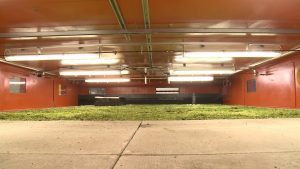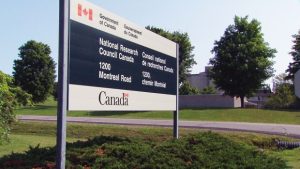Intensive research continues on vegetated roof mats
Canada is leading the way creating the “first systematic Pass/Fail technical standard for VRAs in the world,” says wind expert Dr. Bas Baskaran, Ph.D, P.Eng, of the NRC.
Test results will be used to develop the first wind uplift standard of this kind. Sasha Aguilera of Xeroflor Canada and Karen Liu, PhD, Bonar Xeroflor are working closely with the NRC team setting up and monitoring the tests.

The NRC’s Dynamic Roofing Facility in Ottawa, Canada, uses a chamber fan mechanism that simulates the dynamic effects of wind.
After laboratory testing, results will be benchmarked against real world conditions. “The next phase is to monitor vegetative cover on some actual buildings in the Greater Toronto Area under the influence of Mother Nature,” said Dr. Baskaran.
Cutting Edge Green Roof Technology
Xeroflor inventor of the pre-grown vegetated mat, is part of this significant effort as a member of a research consortium led by wind expert Dr. Bas Baskaran of the National Research Council of Canada (NRC).
In addition to this collaboration, Bonar has several in-house scientists who keep Xeroflor on the forefront of cutting edge research. As a green roof pioneer that developed the pre-grown vegetated carpet four decades ago, Xeroflor systems have undergone other stringent tests and are certified for fire and wind. “Fifteen years ago, the late international wind expert Hans Joachim Gerhardt tested Xeroflor systems in Germany for wind uplift resistance,” says Dr. Liu. “Now, we are testing our system with the NRC to ensure that it meets the wind design requirements in Canada.” Professor Gerhardt’s 1999 wind tunnel tests showed that Xeroflor’s patented XF301 green roof system remains secure against wind uplift on 100-metre tall buildings (approximately 30 stories).
Xeroflor’s XF301 pre-vegetated mat is known for its lightweight and low maintenance features which makes it a popular green roof solution for older, even historic, buildings. It has fared successfully on buildings all over the world in strong winds, even hurricane conditions.




